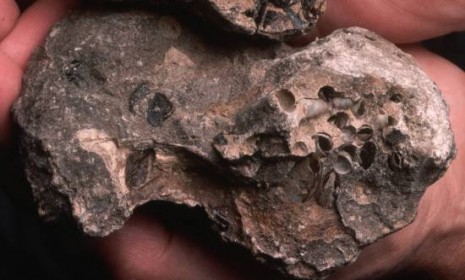The 8-year-old who discovered a $65,000 piece of whale poop
Known as ambergris, this whale excretion is an ultra-rare substance that can fetch thousands of dollars per ounce in the high-end fragrance industry

Charlie Naysmith, 8, was strolling with his dad along the beach in New Zealand when he stumbled on what he thought was a funny-looking rock. The rock was quite compelling, thanks to its surprisingly light weight and faint waxy texture, so young Charlie decided to take it home. As it turns out, the weird rock was actually not a rock at all, but an incredibly rare substance called ambergris, which is, essentially, a very valuable piece of whale poop. Charlie's 1.3-pound piece of ambergris is estimated to be worth somewhere around $65,000. Here's what you should know:
What is ambergris exactly?
There's a "popular misconception of ambergris as whale vomit," molecular biologist Christopher Kemp tells ABC News. In truth, ambergris is "poop." But it's very rare poop. Creating a chunk of ambergris requires "one unlikelihood piled on top of another," says Kemp, and "only one percent of the 350,000 sperm whales [on Earth] can actually make it." Ambergris is essentially made out of a fatty substance that protects a whale's intestines when they feast on hard substances like the beaks of squids. Occasionally, sperm whales dump out hundreds of pounds of the stuff at a time. From there, ambergris has to float around in the ocean for decades, where it has to harden to become valuable.
The Week
Escape your echo chamber. Get the facts behind the news, plus analysis from multiple perspectives.

Sign up for The Week's Free Newsletters
From our morning news briefing to a weekly Good News Newsletter, get the best of The Week delivered directly to your inbox.
From our morning news briefing to a weekly Good News Newsletter, get the best of The Week delivered directly to your inbox.
Why is it so valuable?
Because it's used in the high-end fragrance industry. Ambergris was the main ingredient in a super-expensive, 200-year-old perfume originally made by Marie Antoinette. And today, perfume companies like Chanel and Lanvin use it to "fix scent to human skin," says Johnna Rizzo at National Geographic. A few ounces of the stuff can go for a few thousand dollars, earning it the nickname "floating gold."
What does it smell like?
Each piece of ambergris is slightly different since they're all exposed to varying amounts of sun and seawater. Some are more on the musky side. Others are a bit sweeter. Professional noses at perfume companies are charged with determining the value of each piece of ambergris. "One drop of ambergris can change a perfume," says Claire Payne, an aroma therapist and perfumer.
A free daily email with the biggest news stories of the day – and the best features from TheWeek.com
Is this the largest piece ever found?
No. It isn't even the largest in recent memory. In 2008, two beachcombers were walking their dog along a beach in North Wales when they found a chunk that weighed 110 pounds. It ended up fetching them $790,000.
What does Charlie plan to do now?
While sale of the substance was banned in the U.S. in 1972 because ambergris comes from endangered sperm whales, the boy is planning to sell his in Europe. He says he wants to use the earnings to build a shelter for animals.
Sources: ABC News, Daily Mail, National Geographic, Red Orbit
-
 Political cartoons for December 16
Political cartoons for December 16Cartoons Tuesday’s editorial cartoons include calibrating fonts, Christmas classics, and more
-
 Cryptocurrency and the future of politics
Cryptocurrency and the future of politicsIn The Spotlight From electoral campaigns to government investments, crypto is everywhere and looks like it’s here to stay
-
 Ssh! UK libraries worth travelling for
Ssh! UK libraries worth travelling forThe Week Recommends From architectural delights to a ‘literary oasis’, these are some of the best libraries around the country